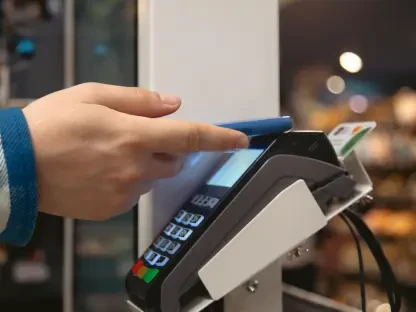Imagine a small town where the nearest bank branch is miles away, leaving residents struggling to access basic financial services like depositing cash or managing funds outside regular hours. This scenario is a reality for many in underserved communities across the UK, highlighting a pressing need for innovative banking solutions. The partnership between PayPoint and Lloyds Banking Group offers a compelling answer, leveraging technology to integrate banking into local retail networks. This review delves into how their cash and card deposit services are transforming accessibility, providing a lifeline for those cut off from traditional banking infrastructure.
Key Innovations in Digital Banking Access
The collaboration between PayPoint and Lloyds Banking Group stands as a pioneering effort to embed financial services into everyday community touchpoints. By utilizing PayPoint’s extensive network of over 3,000 stores, this initiative ensures that banking is no longer confined to brick-and-mortar branches. The technology focuses on bridging gaps in access, particularly for individuals in remote or economically disadvantaged areas, where 99.5% of the population lives within a mile of a PayPoint location.
At the heart of this system lies the seamless integration of digital tools with physical retail spaces. Customers can now perform transactions at local stores during extended hours, addressing a critical pain point for those unable to visit banks during standard operating times. This review examines how such advancements redefine convenience and inclusivity in financial services.
Detailed Analysis of Features and Performance
Cash Deposit Service: A Milestone Achievement
One of the standout features of this partnership is the cash deposit service, branded under the BankLocal initiative. Since its rollout, Lloyds customers have deposited over £3 million, a testament to its widespread adoption. The service’s design prioritizes user convenience, allowing deposits at local retailers with minimal hassle, often outside the typical 9-to-5 banking window.
A striking statistic reveals that over 40% of these transactions occur before 9 a.m. or after 5 p.m., underscoring the demand for flexible banking options. This performance metric highlights how the technology caters to diverse schedules, ensuring that shift workers or busy individuals can manage their finances without disruption. The system’s reliability and reach have made it a vital tool for many.
Beyond mere numbers, the cash deposit service demonstrates robust integration with PayPoint’s infrastructure. Transactions are processed efficiently, maintaining security standards that protect customer data and funds. This feature sets a benchmark for how technology can adapt to real-world needs in community settings.
Card Deposit Capability: Expanding User Options
Building on the success of cash deposits, the recent addition of card deposit functionality marks a significant enhancement. Customers can now deposit up to £300 per transaction using a debit card, complementing the existing barcode option available through the Lloyds mobile app. This feature streamlines the process, catering to varied user preferences with ease.
The technical prowess of this service lies in its speed and security. Funds appear in accounts within minutes, a critical factor for those needing immediate access to their money. The system employs advanced encryption and authentication protocols to safeguard transactions, ensuring trust in a retail-based banking environment.
Performance-wise, the card deposit option has been well-received for its simplicity. Users can complete transactions with minimal steps, reducing friction compared to traditional methods. This addition not only broadens accessibility but also showcases how technology can evolve to meet emerging customer expectations in a dynamic financial landscape.
Community Impact and Retailer Benefits
The practical impact of this technology extends beyond individual users to the communities and retailers involved. Local stores, such as Beaconsfield Cash & Carry in Southall, have emerged as key banking hubs, recording some of the highest transaction volumes. This transformation turns everyday shops into essential service points, strengthening community ties.
For retailers, the benefits are twofold. Participating stores attract new foot traffic, often leading to additional purchases, while also generating extra revenue from transaction fees. This dual advantage reinforces the role of local businesses as integral partners in delivering financial inclusion, supported by PayPoint’s technological framework.
Moreover, the initiative addresses a critical gap in areas with limited bank branches. By embedding banking services into familiar retail spaces, the technology ensures that even the most isolated residents have access to essential financial tools. This community-centric approach amplifies the overall effectiveness of the solution.
Challenges in Scaling Digital Banking Solutions
Despite its successes, scaling this technology across diverse regions presents notable challenges. Technical integration remains a hurdle, as ensuring consistent system performance across thousands of retail locations requires robust infrastructure and ongoing maintenance. Disparities in retailer capabilities can sometimes affect service delivery.
Security is another pressing concern. While current protocols are stringent, expanding to more locations increases the risk of vulnerabilities if not managed diligently. PayPoint and Lloyds must continuously update safeguards to maintain customer confidence in a decentralized banking model.
Lastly, navigating regulatory requirements poses an ongoing obstacle. Compliance with financial laws across different jurisdictions demands careful coordination, potentially slowing expansion efforts. Addressing these issues will be crucial for sustaining growth and ensuring the technology’s long-term viability.
Verdict and Next Steps
Looking back, the partnership between PayPoint and Lloyds Banking Group has proven to be a game-changer in enhancing digital banking accessibility. The cash deposit milestone and the introduction of card transactions showcase a model that effectively meets user needs while supporting local economies. Performance metrics and community feedback paint a picture of a technology that delivers on its promise of convenience and inclusion.
Moving forward, stakeholders should prioritize expanding this model to other financial institutions, potentially integrating additional services like withdrawals or bill payments. Investing in advanced security measures and streamlined technical support for retailers will be essential to overcome existing barriers. Additionally, exploring pilot programs in new regions could refine the approach, ensuring adaptability to varied community needs.
Ultimately, the focus should shift toward creating a blueprint for nationwide adoption, leveraging lessons learned to influence policy on financial inclusion. Collaborations like this have the potential to redefine how banking interacts with underserved populations, paving the way for a more equitable financial ecosystem. Stakeholders are encouraged to build on this momentum, driving innovation that keeps pace with evolving technological and societal demands.









